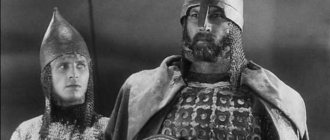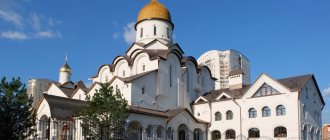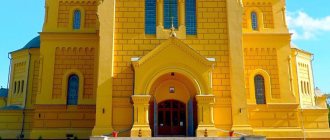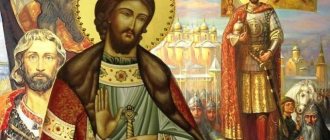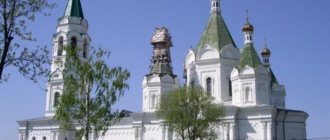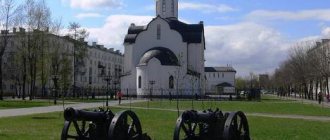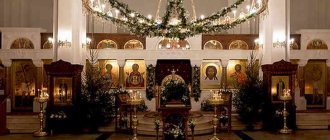During the era of the beginning of the Mongol-Tatar invasion of Rus', such an ancient literary genre as hagiography developed. The changes that were observed in him at this time were associated primarily with new phenomena of reality. The heroes of hagiographic works were not only equal to the apostles, martyrs, and saints, but also people who defended Rus' and the Christian faith from infidel enemies. Recognition of the significance of both spiritual and material feats in the name of the Motherland worthy of depiction led to works of the hagiographic genre using techniques and means characteristic of folk art and military stories.
An example that reveals the presence of new phenomena in the hagiographic genre is “The Tale of the Life of Alexander Nevsky.”
This monument has come down to us in a large number of copies, divided by modern researchers into 9 editions of the 13th-16th centuries; Later editions have also been identified. Many questions about the history of the text remain unclear. Most scholars accept that the original edition of the work was written in the 80s. XIII century in the Monastery of the Nativity of the Virgin Mary in Vladimir on the initiative of Metropolitan Kirill and the son of the hero of the life - Dmitry Alexandrovich, possibly a Galician author. This edition was included in the Laurentian and Pskov II Chronicles as an independent work.
Genre features of “The Tale of the Life of Alexander Nevsky”
In its artistic appearance, “The Tale of the Life of Alexander Nevsky” differs from previous works of the genre by its pronounced combination of features of a military story and life. This was reflected primarily in the composition of the monument. The author retained the traditional introduction and began the main part with a mention of Alexander’s pious parents, as was customary. But instead of a story about the childhood of a hero, whose actions already in this period should have revealed his inherent virtues, a peculiar “portrait” of Alexander Nevsky appears, built on the basis of a comparison of his qualities with the traits of biblical heroes: the strength of Samson, the wisdom of Solomon, the beauty of Joseph, the courage of the Roman King Vespasian. This characteristic serves as an exposition for the development of further action in the life, consisting, as the canon defined, of episodes reflecting the most significant exploits of the protagonist.
The first and most important fragment is the story of Alexander’s battle with the Swedes on the Neva. The motivation for the events is legendary in nature and is associated with the characterization of the hero mentioned above. The author talks about a certain Andreyash, a foreigner, who, having seen Alexander Yaroslavich, praised him in his country. Then the king of this country decided to measure his strength with him and went to war against him. Subsequently, the structure of the story about the Battle of the Neva repeats the structure of a military story: first of all, three main parts characteristic of this genre are clearly distinguished. The first - the preparation of the battle - contains Alexander’s prayer in the Church of Hagia Sophia, the story of the gathering of the army and the speech of the commander, encouraging the soldiers with the famous words: “God is not able, but in truth.” In the story about the performance of the army, the formula “in a small squad” is used, then The exact date of the arrival of the troops at the battle site is indicated according to the church calendar. At the same time, in this part there is an element characteristic of that era, to a greater extent, not of a military story, but of life - the vision of Boris and Gleb to the warrior Alexander Pelguy, which foreshadows victory in a future battle.
The second part of the episode details the battle. First, the exact time of its beginning is indicated - “at 6 o’clock in the afternoon,” and then the author dwells on the exploits of Alexander’s six Novgorod warriors, calling each by name and talking about his deeds. The author emphasizes the courage of the Russian commander, who “put a seal on the queen’s face with his sharp spear.” Along with a specific description of events characteristic of a military story, an element characteristic of hagiographies also appears in this part - a story about a miracle beyond the Izhora River, where the Swedes stood, where Russian soldiers could not pass and where after the battle they found many enemies, “beaten by an angel The Lord's."
The third part of the episode briefly describes the results of the battle.
Thus, this fragment of “The Tale of the Life of Alexander Nevsky” as a whole represents a military story of an event-narrative type, interspersed with two “small genres” that were widely used in lives: vision and miracle.
The subsequent episodes of the central narrative in the life are connected chronologically and represent the most important, from the point of view of the creator of the work, actions of Alexander: the liberation of Koporye and Pskov from the Germans; The Battle of the Ice, the story of which is presented in the form of a military story of an informative type, and the description of the battle is given in military formulas; the prince’s trip to Batu at his request, information about which is legendary; revival of the land after the invasion of Nevruy; refusal to receive Roman ambassadors who wanted to teach the prince their faith. The last part of the narrative consists of a story about Alexander’s death during his return from his second trip to the Horde, a message about the Suzdal people’s farewell to him, the words of Metropolitan Kirill, who called the prince “the sun of the Suzdal land,” and a miracle with a “spiritual letter” that occurred at the time of burial.
Novel by Boris Vasiliev
Boris Vasiliev also made his contribution to the creation of the image of Alexander Nevsky in Russian literature. The famous front-line writer, author of the works “And the Dawns Here Are Quiet...”, “Not on the Lists” and “Don’t Shoot White Swans,” wrote the novel “Alexander Nevsky” in 1997. During that period, the author became seriously interested in historical literature, devoting individual novels to the prophetic Oleg, Princess Olga, Prince Svyatoslav, Vladimir the Red Sun, and Vladimir Monomakh.
Later, the novel about Alexander Nevsky was republished under a different title and is now better known as “Prince Yaroslav and his sons.”
In this book, Boris Vasiliev takes us to Rus' in the first half of the 13th century. At that time, there was no talk of any unity between the principalities; the rulers waged a fierce struggle among themselves for primacy, fought with the German knights, and tried to get along with the Tatar-Mongols, who came to Russian soil in a huge army.
The main characters of this novel are Prince Yaroslav Vsevolodovich and his son Alexander, later nicknamed Nevsky, as well as his younger brother Andrei, who, after a quarrel with the hero of our article, was forced to flee to Sweden. The story contains both real-life historical characters and completely fictitious characters.
Boris Vasiliev, with his usual skill, takes on the task of creating the image of Alexander Nevsky in Russian literature. He creates a fascinating narrative that keeps readers in suspense until the very last pages.
Image system
Undoubtedly, the combination of the traditions of the two genres affected both the system of images and the characteristics of the main character. The central character, as in any life, is one. But along with him, a number of characters appear who perform official functions in relation to him: Andreyash and Batu, who recognize the hero’s superiority over other rulers; the Swedish king testing his military skill and strength; German enemies seizing Russian lands, whom Alexander defeats; ambassadors from Rome, tempting him to accept a different faith and finding themselves put to shame by the hero’s wisdom; Metropolitan Kirill and the people of Suzdal, mourning the death of the prince as a personal grief. A special place is occupied by six Novgorod warriors who distinguished themselves in the Battle of the Neva. Their exploits serve as confirmation of the idea of the prince’s leadership gift and the power of the Russian army, defeating the enemy with small forces. Many of the mentioned characters are more appropriate in a military story than in a life, since they emphasize the worldly, rather than religious virtues of Alexander: courage, determination, leadership, strength and bravery in battle, caring for his people - and only then relying on the help of superiors strength, loyalty to Orthodoxy. In other words, the main character of the hagiography acquires features characteristic of the image of a positive hero-prince in military stories, while at the same time the main way of depicting him remains the idealization characteristic of the hagiography.
"Ratobortsy"
Another important book about Alexander Nevsky is the epic “Warriors,” authored by Alexei Yugov. He wrote it from 1944 to 1948. In it, Grand Duke Alexander Nevsky is shown as one of the main defenders of Rus', along with Prince Galitsky.
In Yugov, Nevsky appears to the reader as a prudent diplomat, as well as a far-sighted and experienced politician, and not just a brave military leader. In this novel, Nevsky is close to the people. This was a consequence of the idealization of his image, as well as the entire era.
It is worth noting that Yugov himself was a supporter of historical concepts, who stood up for everything that was originally Russian, and fought against cosmopolitanism. Even then, such theories were considered by many to be pseudoscientific.
Author's image
The image of the narrator occupies a special place in the work. As in many hagiographies, the narrator begins the work with self-deprecation and assurance of his sincerity, for “wisdom will not enter into an evil soul,” he reports on the sources of the story, which were the stories of “his father” and his own memories, since the author “is a self-witness age" of Alexander, i.e. knew him as an adult. In the work, one can constantly feel the narrator’s admiration for the personality and deeds of the hero, manifested through evaluative epithets, comparisons with biblical characters, emotional digressions (for example, an appeal to the Pskovites with a call to remember the exploits of Alexander and the lamentation of the author, who regrets the death of the prince). Thus, the narrator in the work is similar to the hagiographic image of the narrator.
Music
In 1938, the collaboration between director Sergei Eisenstein and composer Prokofiev began. The main task of the musician was to create music for the filmed plot according to his ideas and opinions. Through music, the composer managed to convey the image of a hero who fought in fierce battles, all this was combined with pictorial episodes and song and choral scenes.
The embodiment of the image of Alexander Nevsky sounded very clearly in the work of Sergei Prokofiev, whose music was written to the words of the poet Lugovsky. It was expressed in such a work as the cantata “Alexander Nevsky”, consisting of seven parts. Each part is intended for different performers: soloist, choir or orchestra, depending on the part: “Battle of the Ice”, “Dead Field”, “Crusaders in Pskov”, etc.
Stylistics of the work
The style of the monument is unique, closely related to the traditions that formed its basis. Undoubtedly, the leading principle is the hagiographic principle, manifested in the widespread use of Church Slavonicisms, quotations from the Bible, and retrospective historical analogies. At the same time, there is no doubt that the influence of military style is evident in the military formulas used in the battle paintings. The greatest similarity was discovered by D.S. Likhachev with a description of military actions in the Galician Chronicle, which gave rise to talk about the Western Russian origin of the author of “The Tale of the Life of Alexander Nevsky”, who was a very educated scribe and knew well, in addition to military and hagiographical traditions, translated works (“Devgenie’s Act”, “Alexandria” ", "History of the Jewish War" by I. Flavius, etc.).
Creating a biography of his contemporary long before his canonization, the author of “The Tale of the Life of Alexander Nevsky” used as a model the tradition of hagiographies - the only ancient Russian genre that gave a biography of the hero. But the real life that he described required the use of literary forms and means characteristic of the widespread and well-known genre of the author - the military story. The combination of two genre traditions while maintaining the leading role of the signs of the life led to the creation of a new hagiographic variety - the life of a warrior prince, later embodied in the “Tale of the Life and Repose of Dmitry Ivanovich, the Russian Tsar” and “The Life of Dovmont of Pskov”.
Source: Old Russian literature of the 11th-17th centuries: textbook. for universities. / Ed. IN AND. Korovina. M.: Vlados, 2003.
"The Youth of a Commander"
The story “The Youth of the Commander” tells about life in Veliky Novgorod, which at that time remained formally independent from the invaders, but at the same time was subject to serious expansion from the west.
Vasily Yan's plans included a big novel about the events of the 13th century, in which the personality of Alexander Nevsky was to be key. But the plan could not be realized due to the death of the writer.
In the story “The Youth of the Commander,” the author focuses on the negative role of feudal fragmentation, which negatively affected the defense capability of Rus'.
